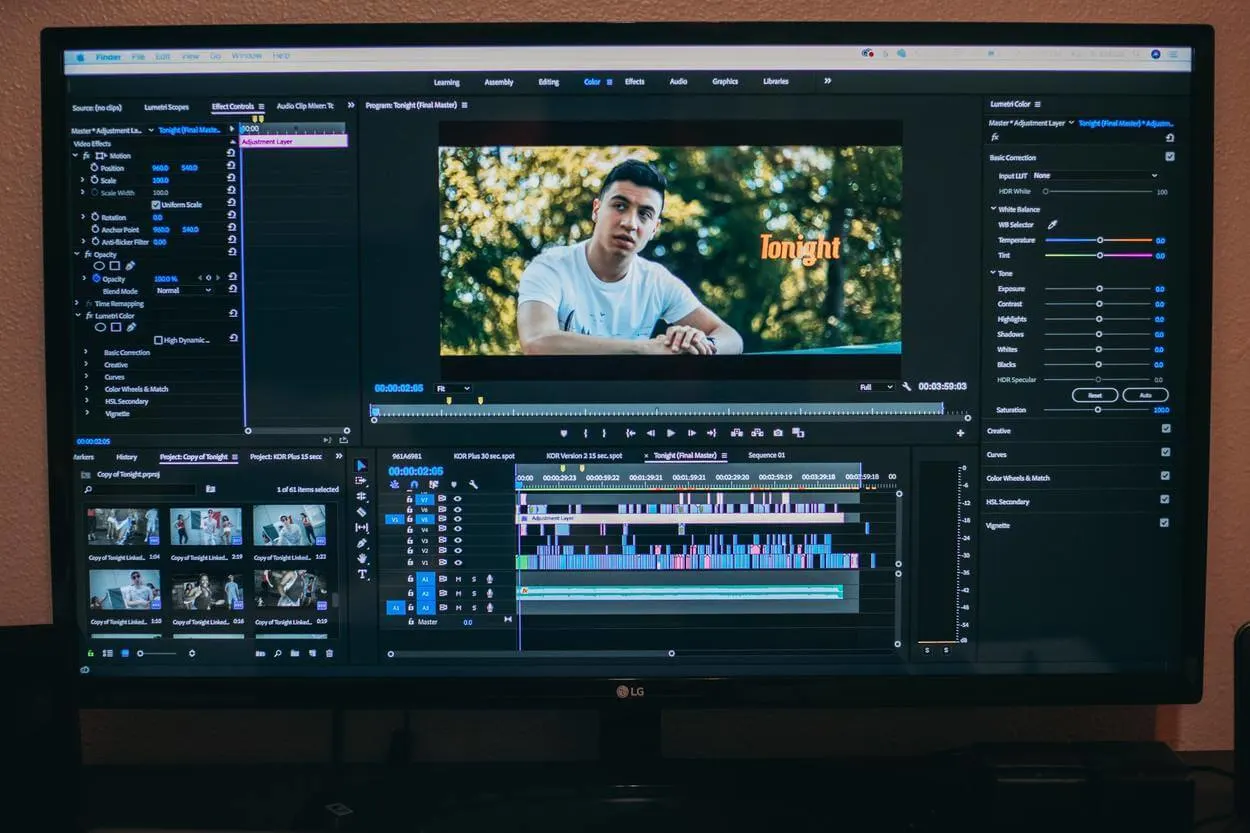The 1080p only talks about the resolution, while the 1080p 60fps is a resolution with a specified frame rate. If your video or settings are 1080p 60fps, it probably has smoother animation and movement. While you wouldn’t experience this in 1080p settings, this doesn’t make the 1080p low quality because it’s already a full high-definition FHD.
Their main difference is that the resolution tells you how clear the image produced would be. Meanwhile, the frame rate is about how smooth the execution of such images will go.
To better understand, let’s start by discussing what screen resolutions and frame rates are.
Let’s get right to it!
What’s a Screen Resolution?
A computer screen uses millions of pixels to display an image. These pixels are usually arranged in a vertical and horizontal grid. So, the number of pixels horizontally and vertically is shown by the screen resolution.
Whether you’re aware or not, this is an essential factor when you consider buying a monitor. This is because the more pixels a screen has, the more visible the images it produces would be.
Therefore, screen resolutions are known to have a pixel count. For instance, a “1600 x 1200” resolution would mean 1600 horizontal pixels and 1200 pixels vertically on a monitor. Moreover, the names or titles of HDTV, Full HD, and Ultra UHD depend on the number of pixels.
However, screen resolution and size are not directly related. This basically means that you can have a 10.6-inch tablet with a screen resolution of 1920 x 1080 or a 15.6-inch laptop with a resolution of 1366 x 768.
Does that mean screen resolution matters more than its size?
What are Frame Rates?
To define it, “frame rates” is the frequency at which the frames in a television picture, film, or video sequence are presented or displayed.
An easier way to understand what frame rates are is by looking at those little flipbooks we had when we were young. The flipbooks had an image drawn on each page, and once you flipped through those pages quickly, the images appeared as if they were moving.
Well, videos work similarly. Videos are a series of still images viewed in a specific order and speed to make them appear in motion. Each image is known as a “frame” or FPS as its unit.
In simpler terms, the frame rate is then the speed at which these images or frames move. It’s similar to how fast you would flip through the flipbook to get a smoother animation and motion.
It’s important to remember that the higher the frame rate, the more it’s supposed to make fast-action scenes look more precise and smoother.
If a video is shot and played at 60fps, then that would mean that there are 60 different images shown per second!

What’s a 1080p Resolution?
1080p resolution is a set of high-definition video modes written as 1920 x 1080. It’s characterized by 1920 pixels displayed horizontally and 1080 pixels displayed vertically.
The “p” in 1080p is short for a progressive scan. A progressive scan is a format used to display, store, or transmit moving images. All these images are drawn in a sequence, which means each frame shows a whole picture.
The common question is whether 1080p is better than HD or not. Well, HD resolution is a lower one and is less sharp because it’s only 1280 x 720 pixels or, in the case of PCs, 1366 x 768 pixels.
Just the fact that the one with more pixels has a better resolution explains why 1080p is a common display resolution. It’s even branded as Full HD or FHD (Full High Definition).
| Resolution | Type | Pixel Count |
| 720p | High Definition (HD) | 1280 x 720 |
| 1080p | Full HD, FHD | 1920 x 1080 |
| 2K | Quad HD, QHD, | 2560 x 1440 |
| 4K | Ultra HD | 3840 x 2160 |
Remember, the more pixels there are in a resolution, the better the visibility will be. It’s going to be more precise and even more detailed!
Is 60fps the Same as 1080p?
No. 60fps refers to the number of frames per second in any resolution, such as 1080p.
60fps is commonly used because it gives you a smoother video, but the setback of using 60fps is that it might feel unrealistic. It might affect your mood while watching because it would appear awkward! As movie lovers, we all want to have a fantastic viewing experience that’s still relatable and not too much.
If you’re confused about which fps to choose, then the context of your video will determine whether you should use a higher fps or a lower one.
Does 60 Fps Make a Difference?
Of course, it can make a big difference in viewing experiences.
So, when choosing a frame rate, one needs to consider many factors. These include how realistic you want your video to look or if you want to use techniques like slow motion or blur. You can also try watching from a distance to lessen its smoothness from your perspective.
After all, the standard Hollywood movies are usually displayed at 24fps. That’s because this frame rate is like how we perceive the world. So, it creates a fantastic cinematic and realistic viewing experience.
On the other hand, live videos or videos that contain a lot of motion, such as video games or sporting events, tend to have higher frame rates. This is because many things are happening in a single frame.
So, a higher frame rate makes sure that the motion is smooth and the details are crisp.

Is 1080p 30fps Better than 1080i 60fps?
Aside from their difference in frame rate per second, the format used in their resolution is different, too.
In 1080p, the whole image or frame is displayed at 60fps, making the image look sharper. In other words, the frame’s lines are displayed in a single pass, one after the other. On the other hand, 1080i uses an interlaced format.
One frame in 1080p is two in 1080i. So, instead of displaying the whole image or frame like what 1080p does, it’s divided into two. It displays half of the frame first and then the next half. Nevertheless, it’s not really noticeable, except that it doesn’t look that sharp.
In short, 1080p 30fps pushes 30 full frames through every second. Whereas 1080i 60ps only displays 60 half frames every second.
Moreover, when shooting a video from your phone, there are multiple video resolution and frames per second options. For instance, here’s a list of video resolution and fps options that the iPhone offers:
- 720p HD at 30 fps
- 1080p at 30 fps
- 1080p at 60fps
- 4K at 30 fps
All these resolutions are HD. Realistically speaking, you’ll view most of the footage you shoot on a tablet, computer, or phone, which is why any of the above resolutions will work.
Is 1080p/60fps Better Than 1080p 30fps?
Yes. 1080p 60fps is definitely better than 1080p. Obviously, the one with 60 frames per second has a higher frame rate. Therefore, it’ll be smoother and clearer.
I’ve stated earlier in the article that the more pixels there are in a resolution, the clearer it’ll be. Similar is the case with frames per second. A higher speed and a higher frame rate will determine the viewing experience of your video by making it appear fast in motion.
Which is Better, Resolution or FPS?
It depends on what you’re looking for.
When it comes to the difference between resolution and frame rates, it’s always fps that dictates how smooth a video or a game runs. It’s also the determining factor in improving playability and frame speed.
On the other hand, resolution determines the number of pixels displayed on the screen and makes a video or a game more visually appealing.

Which is Better, 1080p-30fps or 1080p-60fps?
1080p 60 fps is regarded as better because it has more frames per second. This means a 60fps video has a higher chance of capturing twice as much underlying data than a 30fps video.
When shooting on your phone, you have several different options for the video resolution and the frames per second. Choosing 60fps video speed allows you to maintain a higher quality of slow-motion shots. However, a drawback of 60fps is that it’ll consume more data.
If you want better clarity for your viewers, 60fps is a great option. Although 30fps feels just fine, it has an uneven and raw touch. The jerkiness in 30fps is also noticeable at slower speeds.
Thus, people consider going for the 60fps rate more than the 30fps one when they have both options, especially on smartphones.
The only reason filmmakers stick to 24fps or 30fps is to avoid unrealistic scenes. On the other hand, 60fps allows anyone to capture more movement and allows the option of slowing down the shots.
In fact, 30fps speed is used even by Live TV broadcasts and TV shows, whereas 60fps is used for a broader audience for daily use.
Final Thoughts
- 1080p and 1080p 60fps differ in frame rate, not just resolution.
- Resolution defines image clarity; frame rate impacts smoothness in video.
- Resolution: the number of pixels displayed on a screen horizontally and vertically.
- Frame rate: the speed at which these images or frames are displayed.
- 1080p: 1920 x 1080 pixels, known as Full HD or FHD.
- 60fps provides smoother, more detailed motion in videos.
- Higher fps might appear unrealistic; 24fps or 30fps are used in movies for a cinematic feel.
- 60fps is beneficial for high-motion videos like sports or gaming for clarity and smoothness.
Other Articles
- What Is The Difference Between “Do Not” and “Don’t?”
- M1A1 RIFLE VS. M14 RIFLE (DIFFERENCE)
- HDMI 2.0 VS. HDMI 2.0B (COMPARISON)
Click here to learn more about the differences through the web story.

